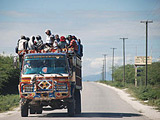Haiti: Young and Volatile
25 Mar 2009
By Béatrice Daumerie for ISN
In 2008, the hurricane season hit Haiti especially hard at a time when the country was already reeling from economic shocks. The devastating tempests Gustav, Hanna and Ike killed more than 800 people and left almost one million homeless - one out of every 10 inhabitants. Earlier in the year, the dramatic rise in food prices led to hunger riots (“émeutes de la faim”). The price of a 50 kg bag of rice jumped from $35 to $70 in a single week and the streets of Port-au-Prince were filled with chants of “Nou Grangou!” (“We are hungry”). Riots and looting caused six deaths and left 170 wounded. The prime minister, Jacques-Edouard Alexis, was forced to resign and a new political crisis was underway.
Crisis, political instability and violence have always been key ingredients in Haiti’s history, but they seem to have intensified over the last two decades. When a military coup led by General Raoul Cédras overthrew the democratically elected government of Jean-Bertrand Aristide in 1991, Haiti entered one of its darkest periods. For many years, the situation worsened, following a downward spiral of economic stagnation, political crisis, violence and large outward migration. Meanwhile, sustained high fertility levels have resulted in a very young age structure.
While the influence of population on political stability and security is certainly not a simple cause-and-effect relationship, a very youthful age structure can potentially exacerbate the development challenges faced by a nation and, in turn, accentuate political instability.
Haiti's age structure, 1975
Haiti's age structure, 2005
Haiti's projected age structure, 2025
Too young, too poorIn Haiti, 15 to 29 year-olds constitute 50 percent of the population, and entering the labor market proves very challenging for them. Between 45 and 55 percent of youth in their twenties are either unemployed or inactive. This does not, however, mean that they are truly inactive. Girls perform hard, unpaid work in the household and in some cases engage in paid sexual activity. As external pagenotedcall_made by Steve Laguerre of Catholic Relief Services, “We have a lot of cross-generational sex between young girls and older men who can provide for them.” Young boys on the other hand may engage in illegal activities, which in the data are reported as inactivity. external pageEighty percentcall_made of violent crimes in the Caribbean are committed by men, the majority of whom are under age 35.
In the capital Port-au Prince, dozens of gangs roam the slums and kill, steal or beat with impunity, while controlling different parts of the city. For a population of less than ten million (half of them children), surveys report 209,000 small arms and light weapons distributed among a multitude of armed groups, including criminal and youth gangs, resistance fronts, death squads, prison escapees, political groups, self-defense militias, private security companies and children. As such, violence is part of everyday life for an overwhelming majority of Haitians in the metropolitan area.
With a succession of military officials ascending to power in recent years, international aid was largely suspended and the Haitian army was left with little capital to pay its soldiers, who began to use their weapons against citizens for their own enrichment. Later, the drug trafficking trade also contributed to the proliferation of violence as Haiti was used by the Colombian cartel as a transshipment point for cocaine. Armed criminal group violence has escalated dramatically since the last military coup in 1994 and have become more brutal since 2000. Members of these murderous groups are usually referred to as external pagezenglendocall_made, who are usually young, independent, audacious and well-armed assassins, principally motivated by banditry and profit. They pose the greatest threat to civil security in the slums and working-class districts of Port-au-Prince.
With more than two-thirds of the population under the age of 15, only 56 percent of the Haitian population is of working age. Compounded by high unemployment rates, demographic realities contribute to Haiti’s economic woes. With only 20 percent of the total population actively employed, every worker has to support on average four people. Most adults are therefore engaged in survival economy with little opportunity to make plans for the future.
Demography, security, economyThe case of Haiti clearly shows that broader demographic factors play an important role in every step of the development process and have an influence on security and economics. In a context of large youth cohorts, labor market opportunities are crucial to absorb this demographic boom and to take advantage of the favorable dependency ratios. Urbanization also plays a key role in understanding the demographic-security nexus. Youth in the metropolitan areas experience far higher levels of crimes, violence and insecurity than in the rest of Haiti. High inactivity rates for those aged 15 to 29 are probably not unrelated to the exponential development of street gangs in Port-au-Prince.
Newly elected Prime Minister Pierre-Louis has promised to address the problems facing Haitian youth. Before becoming prime minister, she was executive director of the privately-funded Foundation for Knowledge and Liberty, and during her ratification hearings she spoke of creating a national service corps to offer opportunities for Haitian youth to rebuild their country.
Addressing the hopelessness of Haitian youth should be the highest political priority in the current demographic context. Offering them labor market opportunities and prospects for a better future is essential for improving the security situation and political stability in Haiti.

